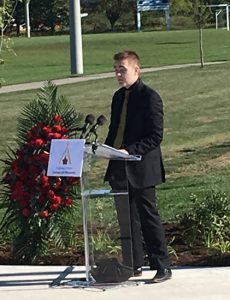
He was the fifth person to speak at the ceremony last Saturday. He followed the MC, the mayor, the military commander, and one of the sponsors of the event. But Logan Caswell’s story about his big brother, Darryl, stopped the audience in its tracks. Logan remembered his 12th birthday. That day, June 11, 2007, Darryl Caswell was going to call from overseas with special birthday greetings. The phone rang at the Caswell’s home in Bowmanville, Ont., that day, but it wasn’t his brother on the line.
“They told us Darryl had been killed by an IED while on a supply convoy north of Kandahar City,” Logan Caswell said.
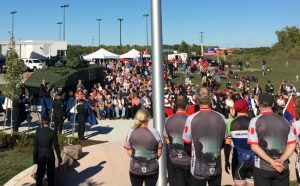
Now 21, Logan spoke on behalf of Memorial Cross Families who lost loved-ones during the 13-year operation in Afghanistan. His short reflective speech was the highlight of last weekend’s unveiling of the Highway of Heroes Durham LAV Monument at Clarington Fields, not far from the Caswell family home. Logan’s brother, Trooper Darryl Caswell, was serving with the Reconnaissance Squadron of the Royal Canadian Dragoons when his Coyote vehicle was blown up by a roadside bomb. Tpr. Caswell was the 57th Canadian casualty in the Afghanistan War.
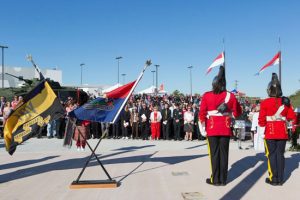
I suggest that Logan Caswell’s moving tribute to his brother proved the most memorable because it gave the ceremony, otherwise preoccupied by the statistics of the war and the campaign to retrieve the Light Armoured Vehicle, some much needed heart.
Other speakers at the unveiling of the LAV had important points to make. Clarington Mayor Adrian Foster wanted the deeds and actions of the 158 Canadians who died Afghanistan to be remembered. Martin Vroegh, of St. Mary’s Cement, promised his firm had “built (the memorial) once, and built it to last.” And Maj. Gen. David Fraser articulated his pride that the LAV Monument would now be a national site remembering the 40,000-plus Canadians who served in Afghanistan.
But Logan Caswell recalled the poignancy of the day – June 16, 2007 – when his brother’s body came home to the Highway of Heroes. He recalled the pain of the long trip from Trenton to Toronto. But what also stuck with him were the highway bridges, full of people wearing red, waving the Canadian Maple Leaf and paying their respects.
When I attend ceremonies such as the LAV Monument unveiling, I look for the humanity, not the artefacts. And on Saturday, I thought, there was a gaping hole in the tribute to the history of the Light Armoured Vehicle, and it was a remarkable human connection to the story.
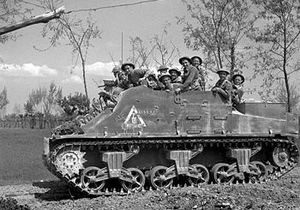
In July of 1944, almost two months after the Allies had landed in Normandy to begin the liberation of northwestern Europe, Canadian and British regiments were badly depleted. In Operation Spring, for example, the North Nova Scotia Highlanders, the Black Watch and the Royal Hamilton Light Infantry sustained nearly 2,000 casualties in a single day’s action. Something had to be done. And it was.
Volunteers to a secret, impromptu workshop, gathered in an orchard near Bayeux, France, and almost overnight transformed a bunch of decommissioned artillery vehicles, called Priests, into improvised troop transports. The Canadian armoured corpsmen scavenged steel plating and improvised the rest to build the first ever armoured personnel carriers to transport Allied troops safely to and from battlefields. G.A. Wiggan, of the Royal Canadian Electrical and Mechanical Engineers, remembered the atmosphere of urgency at this Advanced Workshop Detachment in France.
“There were thirteen units represented in this AWD,” Wiggan wrote, “but inspite of long hours and exhausting work, there was not only no friction, but a wonderful spirit of co-operation from first to last.”
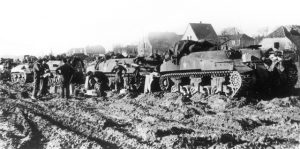
A few weeks later, in time for the beginning of the crucial Operation Totalize, which closed the Falaise gap, the 1st Canadian Armoured Personnel Carrier Regiment had completed 76 transports. The improvised vehicle became known as the “Kangaroo,” the Second World War predecessor of what would become the modern-day LAV in Afghanistan. Just how successful were the Kangaroos at delivering soldiers safely to frontlines and wounded away from them? Well, generally, they reduced losses in transport to almost zero.
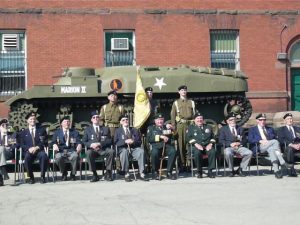
A few years ago I spoke to Kangaroo tanker Colin McMechan. One defining moment occurred as he moved troops of the 51st Highland Division to their starting point against German forces defending the Hochwald Forest in 1945. The infantry major in McMechan’s vehicle was so grateful his unit had reached its objective without losing a man, he pulled out a flask, poured McMechan a shot of Scotch as a token of his appreciation and insisted the Canadian driver drink it on the spot. He did.
“No other regiment, no other organization was able to save the lives of infantry that we saved,” McMechan said. “We saved thousands of lives.”
Unfortunately, armoured technology was not able to save the life of Darryl Caswell in Afghanistan. But what Logan Caswell’s tribute to his brother and memories of the Kangaroos might ensure is that when Canadians visit shrines such as the LAV Monument, they won’t just see hardware, but also the human face of innovation and service.
I was referred to your site by a friend and I was reading this article as I have just recently been involved with two LAV monument dedications in the past few weeks. In the transition between your first paragraph and second paragraph the implication is that Trooper Caswell’s family were notified of his death by the military by phone. I must state unequivocally that the military does not notify families of fallen soldiers by phone. Upon any casualty occurring in the military (overseas or domestic) a notification team comprised of a senior officer and a military padre is raised from the nearest military facility who then attend to the next of kin’s home and deliver the news in person. In the case of an overseas casualty, the standard procedure is to lock down all forms of communication until confirmation of notification of the family is received back in theatre. This procedure was in place during my first tour in 2005, which predates Trooper Caswell’s death. It is possible that someone who knew Trooper Caswell overseas had access to a phone that was not subject to the communications lockdown and called the family of their own accord. I wasn’t there myself, so I could be wrong, but I feel confident in saying that the military would have been at the door in person for this family, just like all of the families who suffered casualties in the war in Afghanistan.